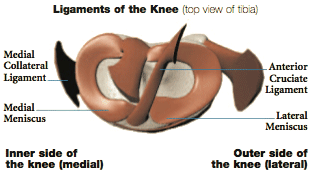 What is the meniscus and how can it be injured?
What is the meniscus and how can it be injured?
The knee joint is buffered by a layer of articular cartilage that caps the ends of the femur (thigh bone) and tibia (shin bone). Another cartilage component, called the meniscus, forms an extra cushion where the leg bones meet to form the knee joint — like a wedged shock absorber that helps distribute weight evenly in the knee.
The meniscus can be injured by trauma or through a degenerative process. Sports injury accounts for most trauma-induced meniscal tears, usually from a bend-and-twist motion. Other injuries may be due to wear-and-tear of more brittle cartilage, a byproduct of the aging process. Often meniscal tears occur at the same time other components of the knee are injured. A common injury among athletes involves simultaneously the anterior cruciate ligament (ACL), the medial collateral ligament (MCL) and the meniscus.
In part due to the “C” shape of the meniscus, tears occur in a number of different locations. Flap, transverse, torn horn and bucket handle rank among the most common tears.
What are the symptoms of a meniscal tear?
You may have heard a popping sound when your injury first occurred. After that, pain and swelling or tenderness may set in. Other symptoms include an inability to move your knee normally, or walk without pain or a clicking, uncomfortable feeling. For some, an injured knee may occasionally get stuck, or lock, at a 45° angle temporarily.
In order to diagnose you properly, your doctor will consider your symptoms, ask you about your activity leading up to the injury, and examine your knee carefully. Because meniscus injuries can also be accompanied by injuries to the other soft tissue in the knee, your doctor will want to look at the big picture. In addition to examining your knee in specific positions and manipulating its movement, your doctor will likely want you to have X-rays (to check for fractures) or an MRI (magnetic resonance imaging).
How is a meniscal tear treated?
Your doctor may recommend different treatment options depending on your particular symptoms and the severity of your injury. Together you will also consider how your injury is affecting your lifestyle and your participation in your favorite activities.
Rest up and stay cool.
Tiny blood vessels feed the edges of the meniscus, giving it the capacity to heal itself in some cases. In addition to asking you to rest, your doctor may prescribe or recommend the use of anti-inflammatory medications (like aspirin or ibuprofen) and cool packs applied to the knee to reduce inflammation and pain.
Get the right moves.
A conservative course of action may serve you well if your doctor determines that you have only a minor meniscal tear, your knee is stable during routine activities, and you completely refrain from participation in any high-risk sports and activities. In this case, your doctor may recommend several specific strengthening exercises to perform on your own throughout the day. In addition, your doctor may require you to commit to a full course of physical therapy. During physical therapy sessions, a trained therapist will work closely with you to help reduce your pain, increase your motion, and improve your thigh and calf strength. As you progress, you will also be taught how to more safely engage in your favorite sport or activity, if appropriate.
Understand your surgical options.
Because a blood supply doesn’t feed the entire cartilage, depending on the extent of your meniscal tear, it may not heal on its own. If you are still experiencing pain after all other conservative measures have been taken, if your lifestyle is compromised by your limitations, or if your tear is complicated by damage to other knee tissue, your doctor may suggest surgery to repair the tear, help relieve your pain and help restore your mobility. Surgical procedures to treat a meniscal tears are aimed at restoring the stability and full function of your knee. Your doctor may recommend a meniscus repair, or a less-invasive procedure called a meniscectomy, in which the torn portion of the meniscus is trimmed and removed.
Today’s techniques, matched with newer instruments, allow your doctor to treat your meniscal tear during arthroscopic surgery (using a fiber optic scope through a small incision), typically on an outpatient basis. Your doctor will repair the injury with surgical solutions that are designed to meet the needs of your injury, such as Stryker’s Meniscal Transplant System.
Be sure to talk with your doctor about the best treatment option for you.
Commit to feeling better.
After surgery, you will likely be able to go home the same day. You may have to wear a splint or brace for a period of time while you heal. Most people use crutches for the first few weeks. Full recovery from meniscal tear repair may take a few months. During that time, you’re your doctor will send you for a course of physical therapy. Complete rehabilitation often depends on your commitment to following your doctor’s recovery recommendations. It is critical that you don’t return to full activity too soon. Your doctor will help you determine how soon after surgery you can safely begin participating in routine, and then more-demanding, activities.